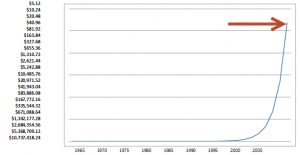Last month, I created a post on the Connection Revolution. I wanted to follow up on that post because I have been reading and thinking about this topic. Frankly, I am very nervous about the changes I see coming (and how they will affect teaching and learning). Given that I am talking on this very subject this afternoon, I thought it appropriate to include this short post. I am very grateful to Doug Orwig for mentioning a book called Flash Foresight by Daniel Burrus. I read this book recently and it really helped clarify many of the ideas which have been circulating in my mind for several years. I encourage others to read this book as well. He has covered many of the same ideas I have been sharing, but Daniel Burrus does it in a much clearer manner. Guess that is why his book is a NY Times best seller.
I have been talking about a coming tsunami of change in the way technology will impact our lives. Amazingly, Daniel Burrus uses the same metaphor in his book. [No, tsunamis are not our friend.] So what is the big deal? Moore’s Law. Essentially, the processing power of computers doubles every 18 months (some say 2 years). This was based on a paper in the mid-1960s and has held true ever since. Ok, I “get it.” So what? This is the analogy used in the Flash Foresight book which I repeat because it should help bring this into greater clarity. Let’s apply Moore’s Law to wages. Assume for a moment that you agree to hire me for 1 penny on the first day, then double my salary every day for a month. Assuming you are not very good at math or don’t understand the implications, you may well think “CHUMP;” he is working for almost nothing. In reality, I am waiting for the end of the month. Starting with one penny, doubling it to two pennies, then four pennies (third day), and so forth, on day 28, my salary is $1,342,177.28, day 29 it doubles again. Day 30 means my salary is $5,368,709.12. I would be hoping for a month with 31 days since it would double again to over $10 million. Note the graphic and numbers below. [Click the image to enlarge.]
Note that I have applied this doubling effect to pennies and charted it (just as Daniel Burrus did in his book). Ok, doubling is impressive. But now, we need to think back to the mid-1960s when Moore’s Law was first proposed. Given that I am writing this in 2012, let’s take a mere 30 cycles at 18 months per cycle. That would equate to 45 years. Going back 45 years takes us to 1967. With respect to processing power – we are at a wall. Every time we experience Moore’s Law from this point forward, the changes will be astronomical.
Of course, bandwidth is also increasing at similar rates. Storage is increasing even faster. Think of the implications this has on teaching and learning. This is why I keep referencing the tsunami of change and the revolution we are presently experiencing. I firmly believe that we have entered a period of unprecedented change. Things considered impossible a few years ago will be possible very soon. We are going to have to deal with problems before they happen. That is the point of Daniel Burrus’ book. BTW – I encourage you to read a copy. One quote from the book really stands out to me:
“We are at the dawn of an era of technology-driven transformation that will make the changes we have experienced over the past twenty five years seem tame, mild, and slow.” Flash Foresight by Daniel Burrus
Let’s start considering what this will mean for teaching and learning in the 21st century. We already have students expecting to learn on any device they have handy (with the materials properly formatted to fit that device). We have expectations that many lessors will include different formats (including video). And… we are just getting started.
I am curious about your thoughts. How do you plan to address these coming changes? What will you be doing differently with respect to teaching and learning? I am hoping we can start a great conversation via the comments below.



Mark,
I’ve been following your thoughts on this topic since I read your blog post on same from this summer. Now I have another resource to consider in Daniel Burrus. Although I am not currently teaching, I have a high interest in the topic since I am still closely working with educators as a Development Director in a Catholic grade school. Many days I am listening to their conversations trying to figure out how they are connecting with this generation.
Hi John:
Glad you find these posts useful. The book in question is a good read, plus he has a periodic newsletter you may find interesting.
Best,
Mark